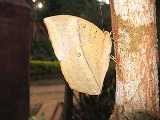
Discophora lepida
Encyclopedia
The Southern Duffer Discophora lepida (Moore
, 1857) is a butterfly
found in India
that belongs to the The Duffers group, that is, the Morphinae
sub family of the Brush-footed butterflies
family.
Resembles Discophora celinde, but in the male the ground-colour on the upperside is dark velvety brown without any blue reflections; the fore wing is crossed preapically by three obliquely-placed, comparatively large, pale-blue spots with an ill-defined series of three or four much smaller subterminal spots ; in the female the markings, though similar to those in the female of celinde, are on the upperside of the fore wing all pale blue, not yellow, and more numerous, larger, and better defined on the upperside of the hind wing. Underside. Male similar to that in male of D. celinde, but a more or less prominent diffuse subterminal band irrorated with lilac scales crosses both fore and hind wing. Female similar to the female of D. celinde, but much paler.
Expanse: 80–104 mm.
and Aitken
)
Frederic Moore
Frederic Moore FZS was a British entomologist. It has been said that Moore was born at 33 Bruton Street but may be incorrect given that this was the address of the menagerie and office of the Zoological Society of London from 1826 to 1836.Moore was appointed an assistant in the East India Company...
, 1857) is a butterfly
Butterfly
A butterfly is a mainly day-flying insect of the order Lepidoptera, which includes the butterflies and moths. Like other holometabolous insects, the butterfly's life cycle consists of four parts: egg, larva, pupa and adult. Most species are diurnal. Butterflies have large, often brightly coloured...
found in India
India
India , officially the Republic of India , is a country in South Asia. It is the seventh-largest country by geographical area, the second-most populous country with over 1.2 billion people, and the most populous democracy in the world...
that belongs to the The Duffers group, that is, the Morphinae
Morphinae
Morphinae is a subfamily of Nymphalidae butterflies that includes the morphos, the owl butterflies and related lineages. It is either considered a sister group of the Satyrinae, or disassembled and included therein.- Systematics :...
sub family of the Brush-footed butterflies
Nymphalidae
The Nymphalidae is a family of about 5,000 species of butterflies which are distributed throughout most of the world. These are usually medium sized to large butterflies. Most species have a reduced pair of forelegs and many hold their colourful wings flat when resting. They are also called...
family.
Description
- See glossaryGlossary of Lepidopteran termsThis glossary describes the terms used in the formal descriptions of insect species, jargon used mostly by professionals or entomologist....
for terms used
Resembles Discophora celinde, but in the male the ground-colour on the upperside is dark velvety brown without any blue reflections; the fore wing is crossed preapically by three obliquely-placed, comparatively large, pale-blue spots with an ill-defined series of three or four much smaller subterminal spots ; in the female the markings, though similar to those in the female of celinde, are on the upperside of the fore wing all pale blue, not yellow, and more numerous, larger, and better defined on the upperside of the hind wing. Underside. Male similar to that in male of D. celinde, but a more or less prominent diffuse subterminal band irrorated with lilac scales crosses both fore and hind wing. Female similar to the female of D. celinde, but much paler.
Expanse: 80–104 mm.
Larva
"Cylindrical or slightly fusiform; bead large; anal segment furnished with two stout conical processes widely separated, but scarcely divergent ; colour of head greenish yellow; eyes black ; body brown, with a broad pure white dorsal band flanked with conspicuous black marks, and a yellow lateral mark on segments 6 to 11 ; head and body clothed with long reddish or brown hair." (Davidson, BellThomas Reid Davys Bell
Thomas Reid Davys Bell , born in Bandon, Cork, was a lepidopterist and forest officer in India.Thomas was the youngest in a family of twelve. His early education was in Dresden. He tried to get into the Indian Civil Services but failed. He later wrote entrance exams to Sandhurst and Woolwich,...
and Aitken
Edward Hamilton Aitken
Edward Hamilton Aitken was a civil servant in India, better known for his humorist writings on natural history in India and as a founding member of the Bombay Natural History Society...
)

